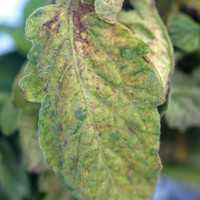
Identification
Early symptoms of GRSV infection are difficult to diagnose. In young infected plants, the characteristic symptoms consist of inward cupping of leaves and leaves that develop a bronze cast followed by dark spots. As the infection progresses, additional symptoms develop, which include dark streaks on the main stem and wilting of the top portion of the plant. Necrotic lesions on stem and petiole epidermal tissues may also be present. Fruit may be deformed, show uneven ripening, and often have raised bumps on the surface. Once a plant becomes infected, the disease cannot be controlled.
Survival And Spread
Alternate hosts for GRSV in Florida are not currently known and need to be explored. The narrow host range of GRSV contrasts with the extremely wide host range of tomato spotted wilt virus, (TSWV), a tospovirus that is common in the southeastern U.S. and closely related to GRSV. Both viruses induce similar symptoms on tomato necessitating serological or molecular tests to accurately identify which virus is present.
GRSV is transmitted exclusively by several species of thrips. The virus must be acquired by larval thrips for subsequent transmission as adults. Reported GRSV vectors include the western flower thrips (Frankliniella occidentalis), common blossom thrips (F. schultzei), and F. gemina.
Transmission occurs in a circulative propagative manner, meaning that the virus multiplies in the vector. Nymphs must emerge on an infected host plant to be able to acquire the virus, which is then spread by the adult insects.
Management Methods
Control of this disease is difficult. To prevent spread of the virus, infected plants should be immediately rogued to prevent spread to neighboring plants. Control of insects — especially thrips — is important to reduce spread of the virus by vectors.
The close relationship of GRSV and TSWV likely indicates that integrated management strategies, including the use of virus-free transplants by excluding thrips from plant houses and use of metalized (UV-reflective) mulch developed for TSWV by scientists at the University of Florida’s North Florida Research and Education Center in Quincy, also will be effective for GRSV. This integrated management approach combines the use of insecticides to reduce thrips larval development and thus limit secondary virus spread.
Variety Spotlight on Two New Blueberries for Growers
The combination of UV-reflective mulches, acibenzolar-S-methyl (Actigard, Syngenta Crop Protection), and insecticides has provided excellent management of TSWV in commercial tomato fields.
0
1
5
Pest Of The Month: Groundnut Ringspot Virus
Gene McAvoy is a Regional Vegetable Extension Agent IV Emeritus for the University of Florida Institute of Food and Agricultural Sciences. In addition, he is President of his own company Have Gun Will Travel Agricultural Consulting. See all author stories here.











